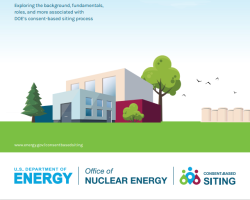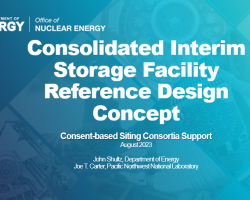Category of Content
Siting Experience Documents Only
Publication Date
Subject Matter
Keywords
Generic Design Alternatives for Dry Storage of Spent Nuclear Fuel
Generic Design Alternatives for Dry Storage of Spent Nuclear Fuel
Public Preferences Related to Consent-Based Siting of Radioactive Waste Management Facilities for Storage and Disposal: Analyzing Variations over Time, Events, and Program Designs
Public Preferences Related to Consent-Based Siting of Radioactive Waste Management Facilities for Storage and Disposal: Analyzing Variations over Time, Events, and Program Designs
Socio-technical multi-criteria evaluation of long-term spent nuclear fuel management strategies: A framework and method
Socio-technical multi-criteria evaluation of long-term spent nuclear fuel management strategies: A framework and method
In the absence of a federal geologic repository or consolidated, interim storage in the United States, commercial spent fuel will remain stranded at some 75 sites across the country. Currently, these include 18 “orphaned sites” where spent fuel has been left at decommissioned reactor sites.
Interim Storage, Environmental Justice, and Generational Equity
Interim Storage, Environmental Justice, and Generational Equity
With the termination of the Yucca Mountain project, which was proposed to be our nation’s first repository for the disposal of military and civilian spent nuclear fuel and high-level radioactive waste, the future of nuclear waste management and disposal in this country became increasingly uncertain. Interim storage has been advocated by many as a temporary solution while a permanent solution is studied for potentially several more decades to come.
Fostering stakeholder involvement across generations - participation after site selection
Fostering stakeholder involvement across generations - participation after site selection
In October 2022, the NEA Forum on Stakeholder Confidence (FSC) organised, in collaboration with the Belgian Agency for Radioactive Waste and Enriched Fissile Materials (ONDRAF/NIRAS), a national workshop in Dessel, Belgium, to explore the topic of stakeholder involvement across generations.
Building on previous work on this topic, participants gathered to discuss how to keep local communities involved in radioactive waste management after site selection, how to engage youth as key stakeholders and which approaches can be used to communicate with stakeholders now and in the future.
The Morally Desirable Option for Nuclear Power Production
The Morally Desirable Option for Nuclear Power Production
This paper reflects on the various possible nuclear power production methods from an ethical perspective. The production and consumption of nuclear power give rise to the problem of intergenerational justice; in other words, we are depleting a nonrenewable resource in the form of uranium while the radiotoxic waste that is generated carries very long-term potential burdens. I argue that the morally desirable option should therefore be to seek to safeguard the interests of future generations.
Reset of America's Nuclear Waste Management Strategy and Policy
Reset of America's Nuclear Waste Management Strategy and Policy
The U.S. nuclear waste management program has labored for decades at a cost of billions of dollars each year, and yet there is still no active disposal program either for spent nuclear fuel from commercial reactors or for the high-level radioactive legacy waste and spent nuclear fuel from defense programs.
U.S. Nuclear Plant Shutdowns, State Interventions, and Policy Concerns
U.S. Nuclear Plant Shutdowns, State Interventions, and Policy Concerns
The United States has the largest nuclear power plant fleet in the world, with 93 reactors that can generate approximately 95,522 megawatts (MW) of electricity. Nuclear power has accounted for about 20% of annual U.S. electricity generation since the late 1980s; in 2020 it was 19.7%. However, the U.S. nuclear power industry in recent years has been facing economic and financial challenges, particularly plants located in competitive power markets where natural gas and renewable power generators influence wholesale electricity prices. Twelve U.S.
Interim Storage, Environmental Justice, and Generational Equity
Interim Storage, Environmental Justice, and Generational Equity
With the termination of the Yucca Mountain project, which was proposed to be our nation’s first repository for the disposal of military and civilian spent nuclear fuel and high-level radioactive waste, the future of nuclear waste management and disposal in this country became increasingly uncertain. Interim storage has been advocated by many as a temporary solution while a permanent solution is studied for potentially several more decades to come.
Transportation Planning: Indigenous Dialogue
Transportation Planning: Indigenous Dialogue
In 2019, the NWMO commissioned Maawandoon Inc to lead Indigenous Dialogue session to support NWMO’s transportation planning for the long-term care of Canada’s used nuclear fuel. This research built upon and complemented public attitude research carried out in 2017 and 2018. The research methodology consisted of 7 Indigenous dialogue sessions and attendance at 3 Indigenous Annual General Assemblies (AGA)/meetings with dialogue components.
A Journey Through a Hypothetical Consolidated Interim Storage Facility
A Journey Through a Hypothetical Consolidated Interim Storage Facility
The hypothetical facility shown in this animation has not been sited or licensed. It is one concept intended only to demonstrate what a potential federal consolidated interim storage facility for commercial spent nuclear fuel could look like based on a set of operating assumptions.
Thermal Modeling of NUHOMS HSM-15 and HSM-1 Storage Modules at Calvert Cliffs Nuclear Power Station ISFSI
Thermal Modeling of NUHOMS HSM-15 and HSM-1 Storage Modules at Calvert Cliffs Nuclear Power Station ISFSI
Communicating Risks and Benefits: An Evidence-Based User's Guide
Communicating Risks and Benefits: An Evidence-Based User's Guide
Effective risk communication is essential to the well-being of any organization and those people who depend on it. Ineffective communication can cost lives, money, and reputations. Communicating Risks and Benefits: An Evidence-Based User's Guide provides the scientific foundations for effective communication.
Monitored Retrievable Storage Facility Conceptual Design Report
Monitored Retrievable Storage Facility Conceptual Design Report
Monitored Retrievable Storage Facility Design Criteria Policy Document - 2nd Draft
Monitored Retrievable Storage Facility Design Criteria Policy Document - 2nd Draft
Application of Sensitivity/Uncertainty Methods to Burnup Credit Criticality Validation
Application of Sensitivity/Uncertainty Methods to Burnup Credit Criticality Validation
OECD/NEA Burnup Credit Criticality Benchmark, Analysis of Phase II-B Results: Conceptual PWR Spent Fuel Transportation Cask
OECD/NEA Burnup Credit Criticality Benchmark, Analysis of Phase II-B Results: Conceptual PWR Spent Fuel Transportation Cask
Consent-Based Siting Process for Federal Consolidated Interim Storage of Spent Nuclear Fuel
Consent-Based Siting Process for Federal Consolidated Interim Storage of Spent Nuclear Fuel
In this document, the U.S. Department of Energy (DOE) outlines its road map for implementing a consent-based siting process to site one or more federal consolidated interim storage facilities for spent nuclear fuel.
Research Supporting Implementation of Burnup Credit in the Criticality Safety Assessment of Transport and Storage Casks
Research Supporting Implementation of Burnup Credit in the Criticality Safety Assessment of Transport and Storage Casks
SCALE-4 Analysis of Pressurized Water Reactor Critical Configurations: Volume 3-Surry Unit 1 Cycle 2
SCALE-4 Analysis of Pressurized Water Reactor Critical Configurations: Volume 3-Surry Unit 1 Cycle 2
Survey of National Programs for Managing High-Level Radioactive Waste and Spent Nuclear Fuel: 2022 Update
Survey of National Programs for Managing High-Level Radioactive Waste and Spent Nuclear Fuel: 2022 Update
In October 2009, the U.S. Nuclear Waste Technical Review Board (Board or NWTRB) published Survey of National Programs for Managing High-Level Radioactive Waste and Spent Nuclear Fuel. For each of the 13 national programs studied, the report catalogued 15 institutional arrangements that had been set in place and 15 technical approaches that had been taken to design repository systems for the long-term management of high-activity radioactive waste.
Helping a Community Control its Future: Potential Negotiating Packages and Benefits for an MRS Host
Helping a Community Control its Future: Potential Negotiating Packages and Benefits for an MRS Host
The voluntary siting process for the Monitored Retrievable Storage (MRS) facility set forth in the Nuclear Waste Policy Amendments Act (NWPAA) of 1987 provides a potential host community a unique opportunity to improve its present situation and to gain greater control over its future.
Consolidated Interim Storage Facility Reference Design Concept
Consolidated Interim Storage Facility Reference Design Concept
Presentation slides on the Consolidated Interim Storage Facility Reference Design Concept, including site plans; handling, inspection and repackaging concepts and facilities; and cost and staffing estimates.
Summary of Consolidated Interim Storage Advantages and Disadvantages from an Integrated Systems Perspective from Prior Reports and Studies
Summary of Consolidated Interim Storage Advantages and Disadvantages from an Integrated Systems Perspective from Prior Reports and Studies
The question of whether centralized storage of civilian spent nuclear fuel (SNF) should be part of the federal waste management system as an intermediate step before permanent disposal has been debated for more than four decades. Centralized storage facilities were included as a potential component of the U.S. spent fuel management system in the Nuclear Waste Policy Act of 1982 (NWPA), but the NWPA did not identify these facilities as being essential.




